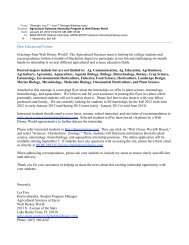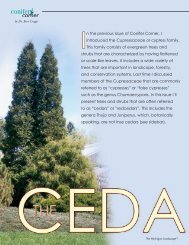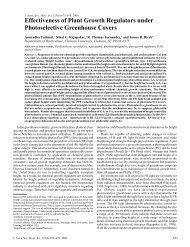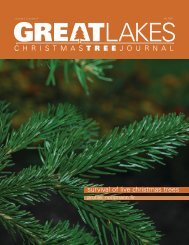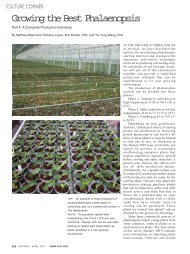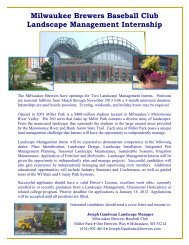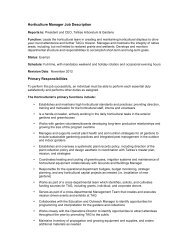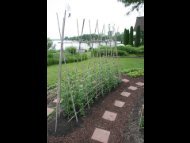Dario Stefanelli - HortScience
Dario Stefanelli - HortScience
Dario Stefanelli - HortScience
Create successful ePaper yourself
Turn your PDF publications into a flip-book with our unique Google optimized e-Paper software.
and tree performance under adverse conditions<br />
(Ferree and Carlson, 1987).<br />
Because organic OFMS create environmental<br />
conditions that are different from the<br />
conventional practices in which rootstocks<br />
are evaluated, our hypothesis was that rootstock<br />
choice may compensate and overcome<br />
these differences. The objectives of this work<br />
were to evaluate the responses of selected<br />
rootstocks to different growing conditions<br />
present in the OFMSs (mulch, propane flame<br />
burning, and the SSS) and to determine the<br />
suitability for growers interested in alternative<br />
OFMSs under an organic protocol.<br />
Materials and Methods<br />
Table 1. Timetable summary on the history of the site and treatments, sampling, and measurements for the<br />
duration of the experiment.<br />
Time period<br />
Soil management, cultural practice/measurement collected<br />
>1998 Conventional soybean–maize–maize–alfalfa rotation (two cycles);<br />
last crop was corn; minimal tillage<br />
1999 Spring: tillage, sowing of soybean, chicken compost (1250 kgha –1 ),<br />
lime (2250 kgha –1 ); fall: tillage, sowing of buckwheat<br />
2000 April: tillage, tree planting; August: sowing of mammoth red<br />
clover and endophytic rye grass in the alleys/TCA<br />
2001 May: implementation of the three orchard floor management systems/TCA,<br />
TCAI, shoot growth, canopy volume, leaf nitrogen content, SPAD, soil sampling,<br />
and soil moisture<br />
2002–2005 Maintenance of the OFMSs and tree training/TCA, TCAI, shoot growth, canopy volume,<br />
leaf nitrogen content, SPAD, soil sampling, soil moisture, and yield from 2003<br />
OFMSs = orchard floor management systems; TCA = trunk cross-sectional area; TCAI = trunk crosssectional<br />
area increase.<br />
An experimental orchard of ‘Pacific Gala’<br />
apple trees (Malus ·domestica Borkh.) was<br />
planted in Apr. 2000 at the Clarksville<br />
Horticulture Research Station in Clarksville,<br />
MI. The predominant soil type of the orchard<br />
and the surrounding areas is Kalamazoo<br />
sandy clay loam (Typic Hapludalfs) with<br />
53.1% sand, 23.1% silt, and 23.8% clay.<br />
The orchard is situated on mild slopes (less<br />
than 3%).The site was previously farmed<br />
with a conventional soybean–maize–maize–<br />
alfalfa rotation for two cycles until 1998.<br />
Subsequent soil preparation consisted of<br />
sowing of buckwheat (Fagopyrum esculentum,<br />
L.) and chicken manure compost (1250<br />
kgha –1 ) and lime (2250 kgha –1 ) application<br />
in 1999 on the entire soil surface. At planting<br />
(Apr. 2000), a mixture of mammoth red<br />
clover (Trifolium pratense var. perenne L.)<br />
and endophytic rye grass (Lollium perenne, L.<br />
infected with Neotyphodium lolii, L.) was<br />
sown in the alleys (Table 1). The orchard was<br />
certified organic in 2003 and 2004 by the<br />
Organic Crop Improvement Association and<br />
in 2005 by Organic Growers of Michigan.<br />
Data collection for this study was initiated in<br />
2002 and ended in 2005.<br />
The rootstocks under evaluation were the<br />
dwarfing M.9 NAKB 337 (40% of the size of a<br />
normal seedling; Marini et al., 2000), the<br />
semidwarfing M.9 RN 29 (Perry, 2000a), and<br />
the semivigorous Supporter 4 (Perry, 2000b).<br />
Spacing between the trees was dependent<br />
on rootstock vigor (Perry, 2002) and was<br />
4.6 · 1.4 m for M.9 NAKB 337 (1553 tree/<br />
ha), 4.6 · 1.7 m for M.9 RN 29 (1279 tree/ha),<br />
and 4.6 · 2.0 m for Supporter 4 (1087 tree/ha).<br />
Trees were trained to a vertical axis<br />
system. Rubber bands and clothes pins were<br />
used to bend branches in establishment years<br />
(Perry, 2000c). Minimal pruning was applied<br />
to allow the tree to grow as naturally as<br />
possible to create a leader or main branches<br />
(Perry, 2000c). A two-wire trellis with galvanized<br />
metal poles was installed as a support<br />
system. Drip irrigation capable of emitting<br />
2.3 Lh –1 every 0.6 m was installed in May<br />
2001 and suspended from the lowest wire of<br />
the trellis on the tree row. All OFMSs<br />
received equal irrigation time and frequency<br />
throughout the seasons.<br />
The OFMS treatments were applied in<br />
2001 (Table 1) and consisted of mulch, SSS,<br />
and flaming with a propane burner. The<br />
primary objective of the treatments was weed<br />
management. The mulch treatment consisted<br />
of alfalfa hay with a carbon:nitrogen ratio of<br />
15:1 applied underneath the tree canopy in a<br />
strip 1 m on each side of the tree at a<br />
minimum thickness of 15 to 20 cm. The<br />
mulch treatment required 115 round alfalfa<br />
bales/ha/year. Nitrogen delivered with each<br />
mulch application was estimated to be 550<br />
kgha –1 . Mulch was hand-applied every<br />
spring and fall to maintain a constant thickness<br />
for weed suppression and maintenance<br />
of soil moisture. No supplementary weed<br />
control was applied. The flame-burning treatment<br />
consisted of heating weeds underneath<br />
the tree canopy and 1 m each side of the tree<br />
using flames generated from burning propane<br />
gas (estimated 56 Lha –1 /year). A customengineered<br />
burner, consisting of four burners<br />
(200,000 BTU each) in a row, with a metal<br />
protective shield to concentrate the heat and<br />
to prevent flame damage to the tree canopy<br />
was used. A sprinkler system was mounted<br />
on the back of the shield to extinguish fires<br />
occurring during treatment application. The<br />
burner was mounted on the side of a tractor<br />
on a hydraulic arm. To reach the weeds<br />
underneath the canopy on the tree row, a<br />
hand burner (150,000 BTU) was used. The<br />
treatment was applied five to six times during<br />
the year, starting in late April/early May and<br />
ending in late August. The treatment was<br />
repeated whenever weeds reached 10 cm<br />
high. Tractor speed was kept between 1.6<br />
and 3.2 kmh –1 depending on the density of<br />
the weeds to be controlled. No additional<br />
fertilization was applied. The SSS we used<br />
was an adaptation of the system developed in<br />
Switzerland (Weibel, 2002) and was applied<br />
to an area 25 to 30 cm on each side of the tree,<br />
underneath the canopy, where vegetation was<br />
allowed to grow undisturbed. On each side of<br />
this weedy area, two strips of soil were kept<br />
free of vegetation by shallow tillage (5 to 10<br />
cm deep). The strips were 70 cm wide from<br />
2001 to 2003 and 90 cm wide from 2004<br />
onward. The width of the strip was modified<br />
to follow tree growth. Timing and frequency<br />
of the treatment application was the same as<br />
the flame-burning treatment. Tillage was<br />
applied by a three-tooth arrow tiller sidemounted<br />
on a tractor on a hydraulic arm<br />
through 2003, a five-tooth arrow tiller in<br />
2004, and a modified notch disk tiller in<br />
2005. The notch disk tiller was modified to<br />
reach the side of the tractor (Fig. 1A–B). No<br />
additional fertilization was applied.<br />
The alley consisted of an equal mixture of<br />
endophytic rye grass and mammoth red<br />
clover seeded at orchard planting. Clover<br />
was reseeded in 2005 to keep the stand<br />
proportion constant. Alleys were not irrigated<br />
and managed equally for all treatments by<br />
periodically mowing (three to four times per<br />
year) and cuttings were left in place according<br />
to best management farming practices.<br />
Soil moisture was measured in each<br />
OFMS by time domain reflectometry (TDR)<br />
using a Mini Trase 6050X3 (Soilmoisture<br />
Equipment Corp., Goleta, CA) with 45-cm<br />
long stainless steel rods permanently<br />
installed in the tree rows halfway between<br />
two trees and in the middle of the tilled strip<br />
in 2002. Measurements were taken weekly in<br />
2002 and every other week from 2003<br />
onward. All expenses, including labor and<br />
equipment use, were recorded in 2005 to<br />
roughly quantify OFMS maintenance costs.<br />
Tree growth variables. We measured<br />
trunk cross-sectional area (TCA), 25 cm<br />
above graft union, at dormancy, as well as<br />
its differential increase (TCAI) since establishment,<br />
for all years. This methodology has<br />
been shown to be highly correlated with tree<br />
growth and vigor in young trees (Westwood<br />
and Roberts, 1970). Shoot growth (extension)<br />
was measured weekly on three representative<br />
shoots per tree and the tree leader during all<br />
vegetative seasons to measure tree growth<br />
Fig. 1. (A) Modified notch disk tiller for the<br />
implementation and maintenance of the Swiss<br />
sandwich system (SSS) tilled strip. (B) Modification<br />
in the disk setup for the notch disk<br />
tiller.<br />
264 HORTSCIENCE VOL. 44(2) APRIL 2009



